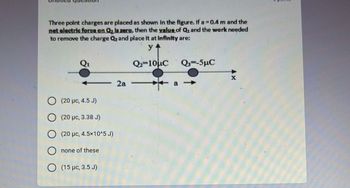Question

Transcribed Image Text:Three point charges are placed as shown in the figure. If a = 0.4 m and the
net electric force on Q₂ is zero, then the value of Quand the work needed
to remove the charge Q₂ and place it at infinity are:
y+
Q-10μC
2a
(20 pc, 4.5 J)
(20 μc, 3.38 J)
(20 μc, 4.5×10^5 J)
none of these
(15 μc, 3.5 J)
Q3=-5μC
-
a→>>
Expert Solution
This question has been solved!
Explore an expertly crafted, step-by-step solution for a thorough understanding of key concepts.
Step by stepSolved in 2 steps with 3 images

Knowledge Booster
Similar questions
- 23.13arrow_forwardIn a magnesium oxide unit, the distance between the magnesium ion (Mg2+) and the oxide ion (O2−) is 1.51×10-10 m. Calculate the work required to separate the two ions to an infinite distance apart. (Model the ions as point charges at rest before and after the separation.)arrow_forward1)What is the electric potential due to the nucleus of hydrogen at a distance of 6.50×10-11 m? Assume the potential is equal to zero as r→∞. (Express your answer to three significant figures.)arrow_forward